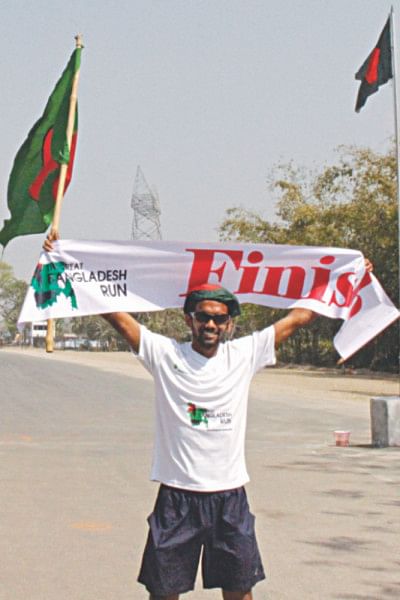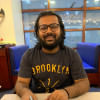From Teknaf to Tetulia

Since when did you harbour the passion of becoming an athlete?
Even though I did not always dream of running a triathlon, I always participated in sports and other athletic activities. An adventure club was being established at Dhaka University when I joined it. That was a perfect opportunity for me to express myself. Through the club, I took part in a wide array of activities, including mountaineering, trekking, running, and more. My first half-marathon was in 2013 at the Cox's Bazaar International Marathon.
What made you take up the Challenge of running from Teknaf to Tetulia?
While swimming the Bangla Channel for second time, which was originally crossed by Lipton Sarkar and discovered by Late Kazi Hamidul Haque, I realised that we should establish a form of extreme sports that could attract athletes. We needed something that would garner a great deal of enthusiasm. This was when I thought of running from Teknaf to Tetulia, which according to the official readings, is 1004 Kilometers long.
Could you briefly talk us through the experience of taking up the gargantuan task, and the hardships that you went through during the run?
When I initially started the run, adrenaline and excitement got the better of me. I ran over 70 kilometers on the first day, which took a hefty toll on my body. After running 350 kilometers, I was worn out. I took a break and carried on, but the biggest obstacle that came in the way was the Jamuna Bridge. Running was not allowed there, and I could not convince the authorities to give me special permission. As a result, I had to take a detour and had to swim a lot of the way across the bridge. That was an impromptu decision, and it could have cost me my life as I did not have any swimming equipment and I ended up covering more kilometers than the official count. Throughout the run, I was accompanied by a crew and my best friend Nasir's mother, who treats me like her own son. I am eternally grateful to them.
Did you get the inspiration to participate in Ironman Malaysia by accomplishing this feat?
It definitely gave me a lot of courage. My advisor and mentor, Mr Neaz Morshed Patwary said that even if I do participate in the event, I should do a half-run as no one actually goes for the full distance the first time. I did not even have any proper experience in cycling, so I knew that I was about to fight an uphill battle. However, I was adamant on going the full distance because I was representing my country for the first time in this event, and I should definitely give it my best.
Some Milestones by Arafat* Finished Ironman Malaysia 2017 Positioned 278 among 1011 * Positioned 2nd in Dhaka Challenge 2017 (First among Bangladeshis) * Ran Teknaf to Tetulia (1004 KM)-2017 in 20 days. * Swam Bangla Channel (Teknaf to Saint Martin's) 3 times in 2015, 2016, & 2017 * Finished SohraCherapunjee Marathon, Meghalaya, India-2016 * Finished Dinajpur Marathon 2016 * Finished Dhaka Half Marathon -2016 * Finished Dhaka Sky Marathon - 2015 * Finished Coxs Bazaar International Marathon 2013 * Finished Run Bangladesh 2017 |
You mentioned that you did not have proper training for cycling. How did you manage to finish in the top third of the tournament?
At that time, I did not even own a proper professional cycle. The only thing that I thought to myself was that I had to participate in this no matter what. I looked for sponsors who could help me get a cycle, but unfortunately could not find any. Thankfully, a friend came forward and let me use his cycle, and I was good to go. Unfortunately, it broke down before the triathlon and I had to lend one from another person during the competition. As luck would have it, the gears for that one didn't work properly. Generally, cycling is considered the easiest part of a triathlon, and I was struggling with that. However, one moment changed everything for me. I noticed that one contender who completed the swimming section was missing an arm. I thought to myself,“If this gentleman is missing one arm and still competing, what excuse do I have?” He really inspired me, and by the grace of the Almighty I could successfully complete the triathlon.
What did you take away from the experience?
Ironman Malaysia is one of the toughest courses in the world, as there are countless uphill and downhill slopes alongside tremendously humid weather. I was elated that I could represent my country. However, I would like to share that the other participating countries had fully professional crews and equipment. If our government can intervene and help athletes properly, we could do a lot better than we are doing right now. The saddest part of the experience was that our flag wasn't hoisted there, as at least 10-15 people from a country need to participate for that. I would definitely like to see more people from our country participating in this event in the coming years.
Tell us about The Great Bangladesh Run. What is the aim of this initiative?
I conceived this initiative to instill fitness and athleticism habits in the people of Bangladesh. We often have programmes, for example a 10-kilometer run at a certain locality in the country. Anyone is free to join and run with me in the event, and the most positive aspect of the initiative is that even elderly people and women have come to run with me. We have recently unveiled our new event called “Kids Run”, which will be held on February 23. We have seen some great accomplishments in the past year. We aim to move towards a fitter and more active Bangladesh within the next ten years.
What can we expect from you in the future?
More of the same. I want to participate in the World Championships of triathlon, for which I have to be in the top five of a major Iron Man competition. I will be working relentlessly for that, without any excuses. Excuses can never create results, but willpower can.

 For all latest news, follow The Daily Star's Google News channel.
For all latest news, follow The Daily Star's Google News channel. 



Comments